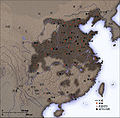tóng-àn:Qin empire 210 BCE TC.jpg
Qin_empire_210_BCE_TC.jpg (555 × 545 siōng-sò͘ , tóng-àn chiàm-liōng: 274 KB, MIME luī-hêng: image/jpeg)
Tóng-àn le̍k-sú
Chhi̍h ji̍t-kî/sî-kan, khoàⁿ hit sî-chūn--ê tóng-àn.
| Ji̍t-kî/Sî-kan | Sáuk-liŏk-dù | Chióh-cháung | Iōng-chiá | Chù-kái | |
|---|---|---|---|---|---|
| hiān-chāi | 2006-nî 11-goe̍h 21-ji̍t (pài-jī) 16:21 |  | 555 × 545(274 KB) | Itsmine | == Commentary == As part of his unification of China in 221 BC, Qin Shi Huang divided his empire into thirty six commanderies, each subdivided into a number of counties. The significance of the administrative reforms was its in |
Iáⁿ-siōng liân-kiat
Í-hā ê ia̍h liân kàu chit ê iáⁿ-siōng:
tóng-àn hō͘ lâng sái--ê chōng-hóng
Ē-kha--ê kî-thaⁿ wiki ēng tio̍h chit--ê tóng-àn:
- incubator.wikimedia.org hō͘ lâng ēng--ê chêng-hêng
- pwn.wikipedia.org hō͘ lâng ēng--ê chêng-hêng
- wuu.wikipedia.org hō͘ lâng ēng--ê chêng-hêng
- za.wikipedia.org hō͘ lâng ēng--ê chêng-hêng
- zh.wikipedia.org hō͘ lâng ēng--ê chêng-hêng




